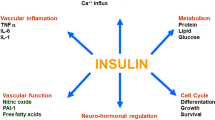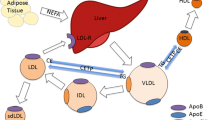Abstract
Purpose
Galectin-3 (Gal-3) is a marker of cardiac fibrosis and predicts incident heart failure. Gal-3-deficient mice are resistant to multiple low-dose streptozotocin-induced diabetes. Recent experimental studies suggested an important role for Gal-3 in the regulation of adiposity, metaflammation and type 2 diabetes. This study aimed to examine the relationship between Gal-3 and newly diagnosed prediabetes and diabetes.
Methods
Gal-3 concentrations were measured in 118 participants and 56 age- and sex-matched healthy controls. All subjects underwent a 75-g oral glucose tolerance test and were stratified into normal, prediabetic, and diabetes mellitus subgroups. DM was defined as a plasma glucose level ≥126 mg/dL in the fasting state or ≥200 mg/dL in the second hour after glucose loading. Impaired fasting glucose was defined as an FPG level of 100–125 mg/dL, and impaired glucose tolerance was defined as a 2-h plasma glucose level of 140–199 mg/dL.
Results
Sixty-one patients had prediabetes (Group 1), 57 had diabetes (Group 2), and 56 had neither diabetes nor prediabetes (Group 3). Gal-3 levels correlated with FPG (r = 0.787, P < 0.01), 2hPG (r = 0.833, P < 0.01), CRP (r = 0.501, P < 0.01), and HOMA-IR (r = 0.518, P < 0.01). Gal-3 levels were higher in Group 2 than in Groups 1 and 3 [1,053.9 (358.1) and 744.1 (119.3) vs. 481.7 (175.4) pg/mL; P < 0.001]. Gal-3 is an independent predictor of diabetes in multivariate logistic analysis. In ROC analysis, a Gal-3 cutoff value of 803.55 pg/mL diagnoses diabetes with a sensitivity of 80.7 % and a specificity of 85.5 % (AUC = 0.912).
Conclusions
Gal-3 is a promising biomarker for detecting prediabetes and diabetes.




Similar content being viewed by others
References
Ho JE, Liu C, Lyass A, Courchesne P, Pencina MJ, Vasan RS, Larson MG, Levy D (2012) Galectin-3, a marker of cardiac fibrosis, predicts incident heart failure in the community. J Am Coll Cardiol 60(14):1249–1256
de Boer RA, van Veldhuisen DJ, Gansevoort RT, Muller Kobold AC, van Gilst WH, Hillege HL, Bakker SJ, van der Harst P (2012) The fibrosis marker galectin-3 and outcome in the general population. J Intern Med 272(1):55–64
van der Velde AR, Gullestad L, Ueland T, Aukrust P, Guo Y, Adourian A, Muntendam P, van Veldhuisen DJ, de Boer RA (2013) Prognostic value of changes in galectin-3 levels over time in patients with heart failure: data from CORONA and COACH. Circ Heart Fail 6(2):219–226
Djoussé L, Matsumoto C, Petrone A, Weir NL, Tsai MY, Gaziano JM (2013) Plasma galectin 3 and heart failure risk in the Physicians’ Health Study. Eur J Heart Fail. doi:10.1002/ejhf.21
Barrow H, Rhodes JM, Yu LG (2013) Simultaneous determination of serum galectin-3 and -4 levels detects metastases in colorectal cancer patients. Cell Oncol (Dordr) 36(1):9–13
Vereecken P, Awada A, Suciu S, Castro G, Morandini R, Litynska A, Lienard D, Ezzedine K, Ghanem G, Heenen M (2009) Evaluation of the prognostic significance of serum galectin-3 in American Joint Committee on Cancer stage III and stage IV melanoma patients. Melanoma Res 19(5):316–320
McCullough PA, Olobatoke A, Vanhecke TE (2011) Galectin-3: a novel blood test for the evaluation and management of patients with heart failure. Rev Cardiovasc Med 12(4):200–210
Mensah-Brown EP, Al Rabesi Z, Shahin A, Al Shamsi M, Arsenijevic N, Hsu DK, Liu FT, Lukic ML (2009) Targeted disruption of the galectin-3 gene results in decreased susceptibility to multiple low dose streptozotocin-induced diabetes in mice. Clin Immunol 130(1):83–88
Pang J, Rhodes DH, Pini M, Akasheh RT, Castellanos KJ, Cabay RJ, Cooper D, Perretti M, Fantuzzi G (2013) Increased adiposity, dysregulated glucose metabolism and systemic inflammation in Galectin-3 KO mice. PLoS One 8(2):e57915. doi:10.1371/journal.pone.0057915
Pejnovic NN, Pantic JM, Jovanovic IP, Radosavljevic GD, Milovanovic MZ, Nikolic IG, Zdravkovic NS, Djukic AL, Arsenijevic NN, Lukic ML (2013) Galectin-3 deficiency accelerates high-fat diet-induced obesity and amplifies inflammation in adipose tissue and pancreatic islets. Diabetes 62(6):1932–1944
Saksida T, Nikolic I, Vujicic M, Nilsson UJ, Leffler H, Lukic ML, Stojanovic I, Stosic-Grujicic S (2013) Galectin-3 deficiency protects pancreatic islet cells from cytokine-triggered apoptosis in vitro. J Cell Physiol 228(7):1568–1576
Darrow AL, Shohet RV, Maresh JG (2011) Transcriptional analysis of the endothelial response to diabetes reveals a role for galectin-3. Physiol Genom 43:1144–1152
Karlsen AE, Størling ZM, Sparre T, Larsen MR, Mahmood A, Størling J, Roepstorff P, Wrzesinski K, Larsen PM, Fey S, Nielsen K, Heding P, Ricordi C, Johannesen J, Kristiansen OP, Christensen UB, Kockum I, Luthman H, Nerup J, Pociot F (2006) Immune-mediated beta-cell destruction in vitro and in vivo—a pivotal role for galectin-3. Biochem Biophys Res Commun 344:406–415
Pugliese G, Iacobini C, Ricci C, Blasetti Fantauzzi C, Menini S (2014) Galectin-3 in diabetic patients. Clin Chem Lab Med 52(10):1413–1423
Weigert J, Neumeier M, Wanninger J, Bauer S, Farkas S, Scherer MN, Schnitzbauer A, Schäffler A, Aslanidis C, Schölmerich J, Buechler C (2010) serum galectin-3 is elevated in obesity and negatively correlates with glycosylated hemoglobin in type 2 diabetes. J Clin Endocrinol Metab 95(3):1404–1411
Yilmaz H, Celik HT, Ozdemir O, Kalkan D, Namuslu M, Abusoglu S, Atalay CR, Yigitoglu R (2014) Serum galectin-3 levels in women with PCOS. J Endocrinol Invest 37(2):181–187
American Diabetes Association (2014) Standards of medical care in diabetes–2014. Diabetes Care 37(Suppl 1):S14–S80
Wallace TM, Levy JC, Matthews DR (2004) Use and abuse of HOMA modeling. Diabetes Care 27:1487–1495
Henderson NC, Sethi T (2009) The regulation of inflammation by galectin-3. Immunol Rev 230(1):160–171
ten Oever J, Giamarellos-Bourboulis EJ, van de Veerdonk FL, Stelma FF, Simon A, Janssen M, Johnson M, Pachot A, Kullberg BJ, Joosten LA, Netea MG (2013) Circulating galectin-3 in infections and non-infectious inflammatory diseases. Eur J Clin Microbiol Infect Dis 32(12):1605–1610
Hotamisligil GS (2006) Inflammation and metabolic disorders. Nature 444:860–867
Dehghan A, Kardys I, de Maat MPM, Uitterlinden AG, Sijbrands EJG, Bootsma AH, Stijnen T, Hofman A, Schram MT, Witteman JCM (2007) Genetic variation, C-reactive protein levels, and incidence of diabetes. Diabetes 56:872–878
Liu S, Tinker L, Song Y, Rifai N, Bonds DE, Cook NR, Heiss G, Howard BV, Hotamisligil GS, Hu FB, Kuller LH, Manson JE (2007) A prospective study of inflammatory cytokines and diabetes mellitus in a multiethnic cohort of postmenopausal women. Arch Intern Med 167:1676–1685
Thorand B, Baumert J, Kolb H, Meisinger C, Chambless L, Koenig W, Herder C (2007) Sex differences in the prediction of type 2 diabetes by inflammatory markers: results from the MONICA/KORA Augsburg case-cohort study, 1984–2002. Diabetes Care 30:854–860
Lee CC, Adler AI, Sandhu MS, Sharp SJ, Forouhi NG, Erqou S, Luben R, Bingham S, Khaw KT, Wareham NJ (2009) Association of C-reactive protein with type 2 diabetes: prospective analysis and meta-analysis. Diabetologia 52(6):1040–1047
Lee CC, Lorenzo C, Haffner SM, Wagenknecht LE, Festa A, Goodarzi MO, Stefanovski D, Olson NC, Norris JM, Rewers MJ, Hanley AJ (2013) The association of inflammatory and fibrinolytic proteins with 5 year change in insulin clearance: the Insulin Resistance Atherosclerosis Study (IRAS). Diabetologia 56(1):112–120
Brunner EJ, Kivimäki M, Witte DR, Lawlor DA, Smith GD, Cooper JA, Miller M, Lowe GD, Rumley A, Casas JP, Shah T, Humphries SE, Hingorani AD, Marmot MG, Timpson NJ, Kumari M (2008) Inflammation, insulin resistance, and diabetes—Mendelian randomization using CRP haplotypes points upstream. PLoS Med 5(8):e155. doi:10.1371/journal.pmed.0050155
de Rn P, Peila R, Ding J et al (2006) Diabetes, hyperglycemia, and inflammation in older individuals: the health, aging and body composition study. Diabetes Care 29:1902–1908
Doi Y, Kiyohara Y, Kubo M et al (2005) Relationship between C-reactive protein and glucose levels in community-dwelling subjects without diabetes: the Hisayama Study. Diabetes Care 28:1211–1213
Lin J, Zhang M, Song F, Qin J, Wang R, Yao P, Ying C, Hu FB, Liu L (2009) Association between C-reactive protein and pre-diabetic status in a Chinese Han clinical population. Diabetes Metab Res Rev 25:219–223
Sabanayagam C, Shankar A, Lim SC, Lee J, Tai ES, Wong TY (2011) Serum C-reactive protein level and prediabetes in two Asian populations. Diabetologia 54(4):767–775
Rhodes DH, Pini M, Castellanos KJ, Montero-Melendez T, Cooper D, et al. (2012) Adipose tissue specific modulation of galectin expression in lean and obese mice: evidence for regulatory function. Obesity (in press)
Kiwaki K, Novak CM, Hsu DK, Liu F-T, Levine JA (2007) Galectin-3 stimulates preadipocyte proliferation and is up-regulated in growing adipose tissue. Obesity 15:32–39
Conflict of interest
We declare no conflict of interest.
Author information
Authors and Affiliations
Corresponding author
Rights and permissions
About this article
Cite this article
Yilmaz, H., Cakmak, M., Inan, O. et al. Increased levels of galectin-3 were associated with prediabetes and diabetes: new risk factor?. J Endocrinol Invest 38, 527–533 (2015). https://doi.org/10.1007/s40618-014-0222-2
Received:
Accepted:
Published:
Issue Date:
DOI: https://doi.org/10.1007/s40618-014-0222-2




